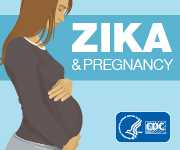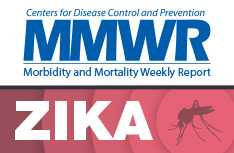Technical and Clinical Information
Lab Evidence of Possible Exposure to Zika Virus
Laboratory evidence of possible Zika virus infection for the US Zika Pregnancy Registry is defined as
- Recent Zika virus infection detected by Zika RNA nucleic acid test (NAT) (e.g., real-time reverse transcription polymerase chain reaction [rRT-PCR]):
- Zika virus RNA detected by NAT on any maternal or fetal/infant clinical specimen (e.g., serum, urine, whole blood, cerebrospinal fluid, amniotic fluid, cord blood, saliva, placenta, umbilical cord tissue, placental membranes, or fetal tissue)
- Recent Zika virus infection or recent flavivirus infection detected by serologic tests of maternal or infant serum or cerebrospinal fluid:
- Zika virus IgM positive or equivocal AND Zika virus plaque reduction neutralization test (PRNT) titer ≥10, (regardless of dengue virus PRNT value) OR
- Zika virus IgM positive or equivocal AND Zika virus PRNT not performed in following state, tribal, local, or territorial health department protocol, OR
- Zika virus IgM negative AND dengue virus IgM positive or equivocal AND Zika virus PRNT titer ≥10 (regardless of dengue virus PRNT titer)
- These inclusion criteria are intentionally broad because of the known cross-reactivity in IgM testing and inability to distinguish between Zika and dengue virus through the use of PRNT.
- If maternal Zika virus IgM and dengue virus IgM are both negative, and maternal PRNT was performed per jurisdictional protocol with Zika virus PRNT titer ≥10, additional testing is needed to meet inclusion criteria. For example, if maternal testing is performed >12 weeks from possible Zika virus exposure and maternal IgM testing is negative with Zika virus PRNT titer ≥10, the mother-infant pair would be included if the infant had Zika virus IgM positive or equivocal, Zika virus RNA or antigen detected, or Zika virus cultured.
- Zika virus infection confirmed by other tests in any maternal or fetal/infant clinical specimen (e.g., serum, urine, whole blood, cerebrospinal fluid, amniotic fluid, cord blood, saliva, placenta, umbilical cord tissue, placental membranes, or fetal tissue)
- Culture of Zika virus
- Detection of Zika virus antigen
*Reviewed and updated on an ongoing basis
Exposure Time Periods
- Periconceptional exposure is defined as maternal Zika virus infection during the 8 weeks before conception (6 weeks before the first day of the last menstrual period).
- Prenatal exposure is defined as fetal exposure to a maternal Zika virus infection during pregnancy but before delivery.
- Perinatal exposure is defined as fetal exposure to maternal Zika virus infection at or around the time of delivery, when a woman is infected with Zika virus within approximately 2 weeks of delivery.
Gestational Age and Trimesters
- The estimated date of delivery (EDD) is a key metric for the US Zika Pregnancy Registry. For a given pregnancy, there should be one EDD established early in pregnancy, based either on the first day of the last menstrual period (LMP) or by ultrasound measurements. EDD estimates are generally determined early in pregnancy and may be confirmed by ultrasound. Ultrasounds early in pregnancy are more accurate to confirm EDD than those later in pregnancy. When questions arise about the most accurate EDD, CDC will work with the health department and if requested, the healthcare provider, to determine the most accurate EDD for the USZPR. It is important to include how EDD was established because this information assists in determining exposure timing and gestational age.
- The USZPR defines pregnancy trimesters using the American Congress of Obstetrics and Gynecology definitions:
- The first trimester begins at 2 weeks after the last menstrual period (2 weeks gestation) and extends for 13 weeks plus 6 days.
- The second trimester begins at 14 weeks gestation and extends until 27 weeks and 6 days.
- The third trimester begins at 28 weeks gestation and extends until delivery.
- Conventions for gestational notation are based on the 7-day week, e.g. gestational age of 25 plus 4 means 25 weeks and 4 days.
Microcephaly
- Zika virus infection during pregnancy is a cause of microcephaly and other severe fetal brain defects.
- Microcephaly is diagnosed when an infant’s head is smaller than expected as compared to infants of the same age (or gestational age) and sex.
- Microcephaly can be determined by measuring head circumference (HC) after birth.
- Although head circumference measurements may be influenced by molding and other factors related to delivery, the measurements should be taken on the first day of life because commonly-used birth head circumference reference charts by age and sex are based on measurements taken before 24 hours of age. The most important factor is that the head circumference is carefully measured and documented. If measurement within the first 24 hours of life is not done, the head circumference should be measured as soon as possible after birth.
- To accurately measure HC use a measuring tape that cannot be stretched. Securely wrap the tape around the widest possible circumference of the head, which is usually one to two finger widths above the eyebrow on the forehead, and then across the most prominent part of the back of the head. This measurement should be repeated 3 times in a row, and the largest measurement to the nearest 0.1 centimeter should be selected.
- More information on microcephaly is available:
- Page last reviewed: April 7, 2017
- Page last updated: April 7, 2017
- Content source:





 ShareCompartir
ShareCompartir